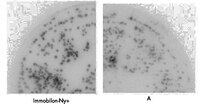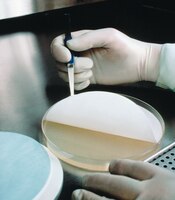Northern and Southern Blotting, and Colony and Plaque Lifts
Recommended Products
Overview
Millipore offers a choice of transfer membranes for nucleic acid applications. For superior results in Southern blotting, northern blotting, and colony/plaque lifts, positively charged Immobilon-Ny+ Transfer Membrane is recommended. Immobilon-NC nitrocellulose transfer membranes, the original matrices used in key Southern and colony plaque protocols, are also available as a less sensitive and more economical alternative.
Immobilon-Ny+ Charged Nylon Transfer Membrane
Immobilon-Ny+ is a positively charged nylon membrane optimized for reliable and reproducible transfer, immobilization, hybridization, and subsequent reprobing. The density and uniformity of the positively charged surface produces maximum sensitivity with minimal background. The membrane is reinforced for enhanced durability, which is especially important in reprobing experiments.
Detailed protocols are available to optimize results of transfers using Immobilon-Ny+ Transfer Membranes.
- Maximum sensitivity with minimal background
- Exceptional reprobing characteristics
- Performs well in both chemiluminescent and radioactive detection systems
Performance
Southern Blotting

Direct comparison of three charged nylon membranes in their own optimized protocols: Each membrane was cross-linked at its recommended UV wavelength. Using these cross-linking conditions, Immobilon-Ny+ membrane had twice the hybridization signal of both competitors.
Signal Intensity after 12 Reprobes

Nylon membranes were cross-linked at 254 nm and underwent multiple reprobes including, in sequence, two hybridizations with 32P-labeled probe, four mock hybridizations, a seventh hybridization with 32P-labeled probe followed by five mock hybridizations and a thirteenth hybridization with 32P-labeled probe. The membranes were stripped in 0.4 M NaOH at 45 °C for 30 minutes between each cycle of hybridization. The mock hybridizations were the same as the true hybridizations except that no 32P-labeled probe was added. Throughout the reprobing process, Immobilon-Ny+ performed better with twice the signal than both Competitor A and B's charged nylon membranes.
Detection Sensitivity

Amount of DNA loaded on the gel was decreased to 0.01 ng. The 2.2 and 2.0 kbp bands in the 0.1 lane correspond to 0.48 and 0.42 pg of DNA, respectively. This is approximately equivalent to a single copy gene sequence in 10 µg of human genomic DNA. The sensitivity was improved by doubling the probe concentration. In the 0.01 ng lanes, Immobilon-Ny+ membrane was slightly more sensitive with lower background than Competitor A.
Northern Blotting with Chemiluminescent Detection

Mouse liver total RNA (1 µg) was resolved on a formaldehyde agarose gel and transferred to Immobilon-Ny+ and a competitor's positively charged nylon membrane "A" by capillary blotting. Fixation of the RNA by UV cross-linking enhanced the signal intensity when compared to baking. Immobilon-Ny+ membrane shows better sensitivity than Competitor A.
Colony Lifts

A mixed bacterial suspension of JM109 carrying pUC19 or pLH2 (2.0 kbp fragment of lambda phage DNA Hind III cloned into pUC19) was plated on LB agar plates and incubated at 37 °C overnight. After chilling the plates at 4 °C for 30 minutes, the colonies (approximately 1–2 mm diameter) were transferred to an 82 mm disc membrane of Immobilon-Ny+ or a competitor's positively charged nylon. The DNA on the membrane was UV cross-linked with 60,000 µJoules/cm2 at 254 nm. The membranes were then hybridized with a 32P labeled DNA probe and visualized using a phosphor imaging system.
Immobilon-NC Transfer Membranes
Immobilon-NC membranes are available as an economical alternative for nucleic acid and protein blotting protocols. These nitrocellulose transfer membranes were the original matrices used in key Southern, colony/plaque, and protein protocols. NC HATF contains mixed cellulose esters matrix with no surfactant to interfere with cell wall integrity during cell growth. Use these membranes for colony lifts. NC HAHY contains mixed cellulose esters with surfactants that improve wettability and handling during the transfer process. Both membranes have a high binding capacity for nucleic acids and proteins. They are suitable for routine transfers.







